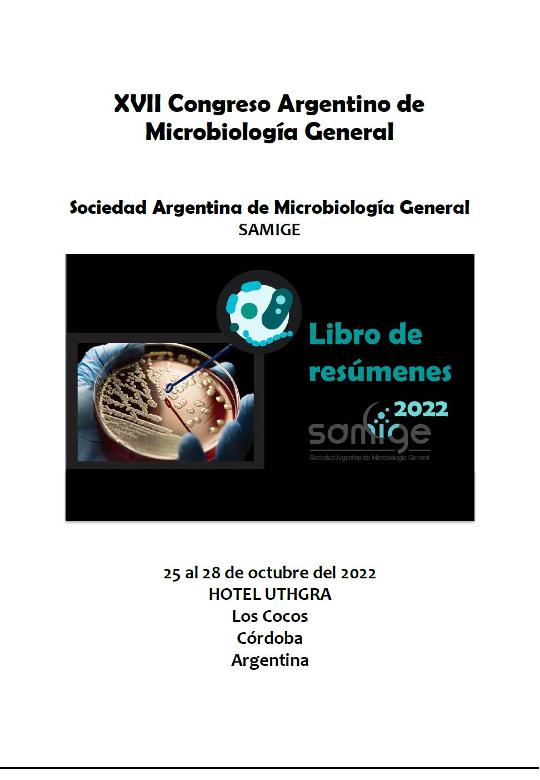Evento
Impact of NaCl on the macromolecular composition of unsaturated Pseudomonas capeferrum WCS358 biofilms
Lacosegliaz, Mariano José ; Torres, Mariela Analía
; Torres, Mariela Analía ; de Cristobal, Ricardo Ezequiel
; de Cristobal, Ricardo Ezequiel ; Nieto Peñalver, Carlos Gabriel
; Nieto Peñalver, Carlos Gabriel
 ; Torres, Mariela Analía
; Torres, Mariela Analía ; de Cristobal, Ricardo Ezequiel
; de Cristobal, Ricardo Ezequiel ; Nieto Peñalver, Carlos Gabriel
; Nieto Peñalver, Carlos Gabriel
Tipo del evento:
Congreso
Nombre del evento:
XVII Congreso Argentino de Microbiología General
Fecha del evento:
25/10/2022
Institución Organizadora:
Sociedad Argentina de Microbiología General;
Título del Libro:
Libro de resúmenes del XVII Congreso Argentino de Microbiología General
Editorial:
Sociedad Argentina de Microbiología General
Idioma:
Inglés
Clasificación temática:
Resumen
High NaCl concentrations in soils affect negatively the production, nutritional, and economic value of crops, as well as its biodiversity. In response to this problem, a large number of studies on plant growth-promoting rhizobacteria (PGPR) have been developed, as they may improve the uptake of water and nutrients and alleviate different types of stresses in plants. These bacteria colonize the rhizosphere forming biofilms that are exposed to constant fluctuations in water availability. For this reason, in this work, we utilize an unsaturated biofilm model as an approximation to the conditions to which rhizobacteria are exposed. Pseudomonas (P.) capeferrum WCS358 produces pyoverdine and induces a systemic response in plants. Its Quorum Sensing (QS) system regulates physiological processes relevant to the colonization of the host and survival. The aim of this work was to analyze the impact of salt stress on growth and the characteristics of the unsaturated biofilm of P. capeferrum WCS358, and the influence of QS regulation. For this, we employed polycarbonate membranes and an artificial root exudates culture medium supplemented with 0.2 M NaCl as saline stress. Membranes were inoculated with bacterial suspensions (0.1 OD600) and incubated at 30 °C for 72 hours. Unsaturated biofilms were broken up by vigorously vortexing the membrane in 1 mL physiological solution. CFU mL-1 was determined after plating serial dilutions. Carbohydrates were quantified using the phenol?sulfuric method with glucose as a standard, extracellular proteins were quantified using the Bradford method. Acyl homoserine lactones (AHLs) production was determined after solvent extraction, separation by thin-layer chromatography, and subsequent detection with bioassays developed with Agrobacterium (A.) tumefaciens NT1 (pZLR4). Results showed that neither saline stress nor QS activity decreased biofilm growth of P. capeferrum WCS358. While the attenuation of the QS activity augmented 13% of the exopolysaccharides in the unsaturated biofilms, NaCl decreased by 28% of these values. Proteins in the matrix were not affected by QS. However, saline stress increased by 30% the protein concentration. RP-TLC developed with A. tumefaciens NT1 (pZLR4) showed smaller and weaker spots of AHLs. We conclude that saline stress and the QS system modify the characteristics of the unsaturated biofilms of P. capeferrum WCS358. At the same time, NaCl modulates the QS activity of this microorganism. These results are relevant for a PGPR, considering the large surfaces of saline soils in our country.
Palabras clave:
NaCl
,
UNSATURATED BIOFILM
,
QUORUM SENSING
,
PSEUDOMONAS CAPEFERRUM WCS358
Archivos asociados
Licencia
Identificadores
Colecciones
Eventos(PROIMI)
Eventos de PLANTA PILOTO DE PROC.IND.MICROBIOLOGICOS (I)
Eventos de PLANTA PILOTO DE PROC.IND.MICROBIOLOGICOS (I)
Citación
Impact of NaCl on the macromolecular composition of unsaturated Pseudomonas capeferrum WCS358 biofilms; XVII Congreso Argentino de Microbiología General; Los Cocos; Argentina; 2022; 154-154
Compartir



